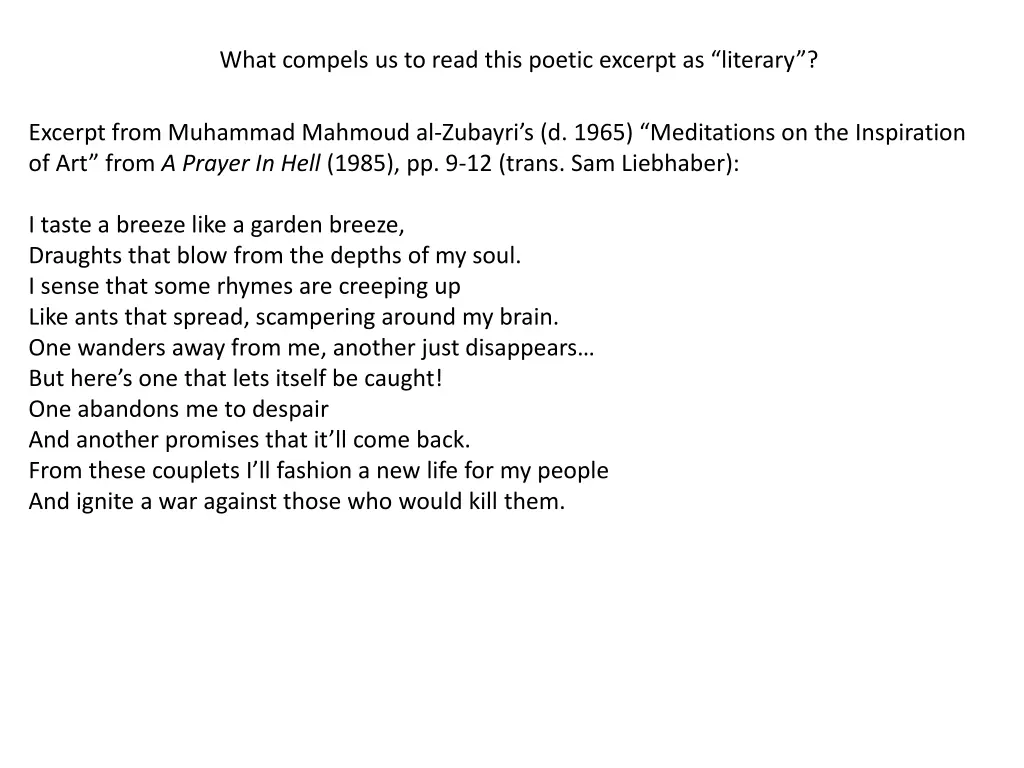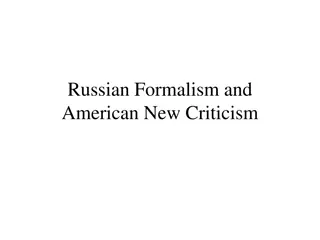
Literary Analysis of Excerpts from Muhammad Mahmoud al-Zubayri's Work
Discover the literary essence in the poetic excerpt by Muhammad Mahmoud al-Zubayri, exploring themes of inspiration and artistry. Delve into the historical relationship between poetry and prose, and delve into ancient literature examples across various languages.
Download Presentation

Please find below an Image/Link to download the presentation.
The content on the website is provided AS IS for your information and personal use only. It may not be sold, licensed, or shared on other websites without obtaining consent from the author. If you encounter any issues during the download, it is possible that the publisher has removed the file from their server.
You are allowed to download the files provided on this website for personal or commercial use, subject to the condition that they are used lawfully. All files are the property of their respective owners.
The content on the website is provided AS IS for your information and personal use only. It may not be sold, licensed, or shared on other websites without obtaining consent from the author.
E N D
Presentation Transcript
What compels us to read this poetic excerpt as literary? Excerpt from Muhammad Mahmoud al-Zubayri s(d. 1965) Meditations on the Inspiration of Art from A Prayer In Hell (1985), pp. 9-12 (trans. Sam Liebhaber): I taste a breeze like a garden breeze, Draughts that blow from the depths of my soul. I sense that some rhymes are creeping up Like ants that spread, scampering around my brain. One wanders away from me, another just disappears But here s one that lets itself be caught! One abandons me to despair And another promises that it ll come back. From these couplets I ll fashion a new life for my people And ignite a war against those who would kill them.
The Fall ... Sometimes I have feeling of loneliness only of descent Vocabulary list, Unit aT if baatiK - la , 5 allum al-Arabiyya, Vol. 1 , 1 st edition
Poetry is easy...how do we detect literaryiness in prose? Corollary: What does this say about the historical relationship of poetry to prose? What are earliest examples of literature in any language?
From The Battle Days of the Arabs: the cause of the war between the tribes of Bakr (Jassas) and Taghlib (Kulayb), in the pre-Islamic era. Note: at the time of the event narrated below, Kulayb ruled over both Bakr and Taghlib, yet was tyrannical, possessive, and arrogant. Also, Jassas and Kulayb are related through marriage. ...al-Basus (the aunt of Jassas) had a she-camel called Sarab. One day, Kulayb s camel- herd passed by Sarab, who was tied in the backyard of Jassas b. Murrah. When Sarab saw the camels, she started to untie herself from the rope until it was cut off, and she followed the other camels and mingled with them. The herd reached Kulayb s private precinct while he was at the watering place holding a bow and an arrow pouch. Kulayb saw Sarab but did not recognize her, so he grabbed an arrow and shot her and pierced her udder. The she-camel was startled and ran back slobbering, and when al-Basus saw her, she threw the veil off her head and cried: O shame! O protector! and she went out. She incited Jassas, who rode his horse and he was very proud of his horse and took his weapon with him. Amr b. al-H arith b. Dhuhl b. Shayban followed him on his own horse carrying his spear, where they both entered Kulayb s private precinct. Jassas said: O Abu al-Majidah [Kulayb], you slaughtered the she-camel of my neighbor [his aunt, Jassas] . Kulayb responded Why you! Do you intend to prevent me from protecting my private precinct? And Jassas became so overwhelmed with anger that he stabbed Kulayb and broke his spinal chord, and Amr b. al-H arith stabbed him from behind and severed his lower back. Kulayb fell to the ground fidgeting and his two legs were twitching
Srat al-Arf(The Heights), from the Quran: verses 73-79, trans. Kenneth Craig, Readings in the Quran (1995): p. 128. Note: the tribe/nation of Thamud is infamous in Islamic historiography for rejecting God s prophet, Salih, and for being utterly destroyed by God as a result. To the tribe of Tham d We sent their brother, S lih, who said: My people, worship God: you have no other god but He. A sign has come to you from your Lord. This is God s she- camel, a symbol for you. Let her be free to graze in God s earth and do her no harm, lest painful punishment take you. Remember how He made you successors to the tribe of d and gave you tenure in the land, so that you build castles on its plains and hew dwellings out of the hills. Remember God s blessings and do not deal corruptly, defiling the land. The elders among his people in their arrogance said to those of their number who believed and whom they considered base: Do you really know that S lih is a messenger from his Lord? They replied: We do believe in the message with which he was commissioned. To which the arrogant folk retorted: We deny what you believe in. They slaughtered the she- camel and disdained the command of their Lord and they said to S lih: If you are indeed a messenger, bring on us what you threaten. What is the relationship between this account and the previous one? How then might we reinterpret the former text as a literary text?
What about the novel? What are they? Why do we like them? Narrative! When do we narrate things? Where can we find narrative? Summer recollections? The news? Nature documentaries?
What sound does this make? The clock s tick-tock I take to be a model of what we call a plot, an organization which humanizes time by giving it a form; and the interval between tock and tick represents purely successive, disorganized time of the sort we need to humanize. -Frank Kermode, The Sense of an Ending: Studies in the Theory of Fiction, p. 45.
What is this? What happened here? Shipwreck: the very word suggests a narrative
The narratives of the world are numberless. Narrative is first and foremost a prodigious variety of genres, themselves distributed amongst different substances as though any material were fit to receive man s stories. Able to be carried by articulated language, spoken or written, fixed or moving images, gestures, and the ordered mixture of all these substances; narrative is present in myth, legend, fable, tale, novella, epic, history, tragedy, drama, comedy, mime, painting stained-glass windows, cinema, comics, news items, conversation. Moreover, under this almost infinite diversity of forms, narrative is present in every age, in every place, in every society; it begins with the very history of mankind and there nowhere is nor has been a people without narrative. All classes, all human groups, have their narratives, enjoyment of which is very often shared by men with different, even opposing, cultural backgrounds. Caring nothing for the division between good and bad literature, narrative is international, transhistorical, transcultural: it is simply there, like life itself. - Roland Barthes, Introduction to the Structural Analysis of Narratives in Susan Sontag (ed.) A Barthes Reader (New York: Hill and Wang, 1982), pp. 251-2.
OK narrative is everywhere. But what distinguishes a narrative in novel form from other types of narrative? Realism fiction pretending to not be fiction Individual focus dynamism located within the individual (not divine realm, heroic types, historical events, etc.) Time and change over time Showing (representation, theater, mimesis) and telling (direct voice, poetry)
OK novel are the characteristic literary genre of the modern era (the 20th century). But what s the point of reading Arabic novels? Sudden appearance and evolutionary acceleration Centrality of the literary act in the Arab world (more so than in the US, for instance). Literary commitment remains an ideal nor did it ever lose it lustre.






















